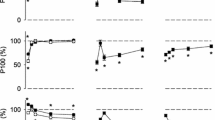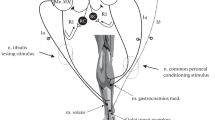Abstract
Percutaneous electrical stimulation was used to study the force response of the quadriceps muscle. The normal frequency dependence of force was investigated in muscles at rest and after fatiguing contractions. A comparison between force response during fatigue induced by electrical stimulation at different frequencies and by voluntary work suggested equal changes in contractility, irrespective of the fatigue-inducing procedure. In fresh muscle we found a linear relation between stimulation period (10–100 ms) and force. At fatigue the relation changes with maximal deviation from linearity at a 50-ms period (20 Hz). There is a rapid recovery of high frequency force whereas the low frequency response remains low even after 30 min rest. At very low frequencies there is initially unexpectedly high force in fatigued muscle. This could be a result of increased fusion of twitches with initially prolonged relaxation time. To study the twitch summation we compared experimental results in a wide frequency range with computer-simulated twitch summations and present the frequency dependence of summation processes in human quadriceps muscle.
Similar content being viewed by others
References
Bates JHT, Janssens S, Jiang TX, Hunter IW, Decramer M (1988) A substractive method for decomposing muscle tension into individual twitches. Comput Biomed Res 21:570–578
Bell GH, Davidson JN, Scarborough H (1959) Textbook of physiology and biochemistry, 4th edn. Livingstone, Edinburgh
Bergström M, Hultman E (1986) Relaxation time during intermittent isometric contraction in subjects with different capacity for oxidative work. Acta Physiol Scand 127:107–110
Bergström M, Hultman E (1988) Energy cost and fatigue during intermittent electrical stimulation of human skeletal muscle. J Appl Physiol 65:1500–1505
Bigland-Ritchie B, Jones DA, Woods JJ (1979) Excitation frequency and muscle fatigue: electrical responses during human voluntary and stimulated contractions. Exp Neurol 64:414–427
Bigland-Ritchie B, Johansson R, Lippold OCJ, Woods JJ (1983) Contractile speed and EMG changes during fatigue of sustained maximal voluntary contractions. J Neurophysiol 50:313–324
Burke RE, Rudomin P, Zajac FE III (1976) The effect of activation history on tension production by individual muscle units. Brain Res 109:515–529
Burnett RW (1980) Quantitative evaluation of linearity. Clin Chem 26:644–646
Chasiotis D, Bergström M, Hultman E (1987) ATP utilization and force during intermittent and continuous muscle contractions. J Appl Physiol 63:167–174
Cooper S, Eccles JC (1930) The isometric responses of mammalian muscles. J Physiol (Lond) 69:377–385
Cooper RG, Edwards RHT, Gibson H, Stokes MJ (1988) Human muscle fatigue: frequency dependence of excitation and force generation. J Physiol (Lond) 397:585–599
Davies CTM, White MJ (1982) Muscle weakness following dynamic exercise in humans. J Appl Physiol 53:236–241
Duchateau J, Hainaut K (1984) Isometric or dynamic training: differential effects on mechanical properties of a human muscle. J Appl Physiol 56:296–301
Duchateau J, Hainaut K (1985) Electrical and mechanical failures during sustained and intermittent contractions in humans. J Appl Physiol 58:942–947
Edwards RHT (1978) Physiological analysis of skeletal muscle weakness and fatigue. Clin Sci Mol Med 54:463–470
Edwards RHT, Young A, Hosking GP, Jones DA (1977) Human skeletal muscle function: description of tests and normal values. Clin Sci Mol Med 52:283–290
Edwards RHT, Hill DK, Jones DA, Merton PA (1977) Fatigue of long duration in human skeletal muscle after exercise. J Physiol (Lond) 272:769–778
Harris RC, Hultman E, Sjöholm H (1984) Contractile response in intact human muscle monitored by the change in intramuscular pressure. J Physiol (Lond) 357: 111P
Hultman E, Sjöholm H (1983) Electromyogram, force and relaxation time during and after continuous electrical stimulation of human skeletal muscle in situ. J Physiol (Lond) 339:33–40
Hultman E, Sjöholm H (1986) Biochemical causes of fatigue. In: Jones NL, McCartney N, McComas AJ (eds) Human muscle power. Human Kinetics, Champaign, Ill, pp 215–238
Hultman E, Sjöholm H, Jäderholm-Ek I, Krynicki J (1983) Evaluation of methods for electrical stimulation of human skeletal muscle in situ. Pflügers Arch 398:139–141
Ren JM, Chasiotis D, Bergström M, Hultman E (1988) Skeletal muscle glucolysis, glycogenolysis and glycogen phosphorylase during electrical stimulation in man. Acta Physiol Scand 133:101–107
Sjöholm H, Sahlin K, Edström L, Hultman E (1983) Quantitative estimation of anaerobic and oxidative energy metabolism and contraction characteristics in intact human skeletal muscle in response to electrical stimulation. Clin Physiol 3:227–239
Snedecor GW, Cochran WG (1967) Statistical methods, 6th edn. Iowa State University Press, Ames, Iowa
Spriet LL, Söderlund K, Bergström M, Hultman E (1987) Anaerobic energy release in skeletal muscle during electrical stimulation in men. J Appl Physiol 62:611–615
Wiles CM, Edwards RHT (1977) Weakness in myotonic syndromes. Lancet II: 598–601
Author information
Authors and Affiliations
Rights and permissions
About this article
Cite this article
Bergström, M., Hultman, E. Contraction characteristics of the human quadriceps muscle during percutaneous electrical stimulation. Pflugers Arch. 417, 136–141 (1990). https://doi.org/10.1007/BF00370690
Received:
Revised:
Accepted:
Issue Date:
DOI: https://doi.org/10.1007/BF00370690




